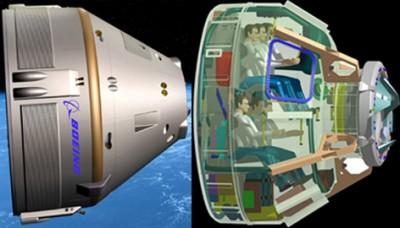Thu, Jun 28, 2012
CST-100 Attitude Control System Will Be Comprised Of Twenty-Four Of The Thrusters
A series of tests on a thruster destined for Boeing's Commercial Space Transportation spacecraft, designated CST-100, was completed recently by Pratt & Whitney Rocketdyne. Boeing is one of several companies working to develop crew transportation capabilities under the Commercial Crew Development Round 2 agreement with NASA's Commercial Crew Program.

Twenty-four thrusters will be part of the spacecraft's orbital maneuvering and attitude control system (OMAC), giving the CST-100 the ability to maneuver in space and during re-entry. The thrusters also will allow the spacecraft to separate from its launch vehicle if an abort becomes necessary during launch or ascent.
"Boeing and Pratt and Whitney Rocketdyne know what it takes to develop safe systems and subsystems," said NASA Commercial Crew Program Manager Ed Mango. "They're building on the successes of their past, while pushing the envelope with next-generation ideas to create a spacecraft for low Earth orbit transportation."
During tests conducted at the White Sands Space Harbor in Las Cruces, NM, an OMAC thruster was fired in a vacuum chamber that simulated a space-like environment of 100,000 feet. The tests verified the durability of the thrusters in extreme heat, evaluated the opening and closing of its valves and confirmed continuous combustion and performance. "We're excited about the performance of the engine during the testing and confident the OMAC thrusters will affordably meet operational needs for safe, reliable human spaceflight," said Terry Lorier, Pratt and Whitney Rocketdyne's Commercial Crew Development program manager.
All of NASA's industry partners, including Boeing, continue to meet their established milestones in developing commercial crew transportation capabilities.
NASA also is developing the Orion spacecraft and Space Launch System (SLS), a crew capsule and heavy-lift rocket that will provide an entirely new capability for human exploration beyond low Earth orbit. Designed to be flexible for launching spacecraft for crew and cargo missions, SLS and Orion will expand human presence beyond low Earth orbit and enable new missions of exploration across the solar system. (Image provided by Boeing)
More News
A Puff Of Smoke Came Out From The Top Of The Engine Cowling Followed By A Total Loss Of Engine Power On May 9, 2025, about 1020 mountain daylight time, an experimental amateur-buil>[...]
From 2022 (YouTube Edition): Jenny, I’ve Got Your Number... Among the magnificent antique aircraft on display at EAA’s AirVenture 2022 was a 1918 Curtiss Jenny painstak>[...]
Very High Frequency (VHF) The frequency band between 30 and 300 MHz. Portions of this band, 108 to 118 MHz, are used for certain NAVAIDs; 118 to 136 MHz are used for civil air/grou>[...]
“From approximately November 2021 through January 2022, Britton-Harr, acting on behalf of AeroVanti, entered into lease-purchase agreements for five Piaggio-manufactured airc>[...]
Microburst A small downburst with outbursts of damaging winds extending 2.5 miles or less. In spite of its small horizontal scale, an intense microburst could induce wind speeds as>[...]
 NTSB Prelim: Lee Aviation LLC JA30 SuperStol
NTSB Prelim: Lee Aviation LLC JA30 SuperStol Classic Aero-TV: Curtiss Jenny Build Wows AirVenture Crowds
Classic Aero-TV: Curtiss Jenny Build Wows AirVenture Crowds ANN's Daily Aero-Term (05.30.25): Very High Frequency (VHF)
ANN's Daily Aero-Term (05.30.25): Very High Frequency (VHF) Aero-News: Quote of the Day (05.30.25)
Aero-News: Quote of the Day (05.30.25) ANN's Daily Aero-Term (05.31.25): Microburst
ANN's Daily Aero-Term (05.31.25): Microburst



